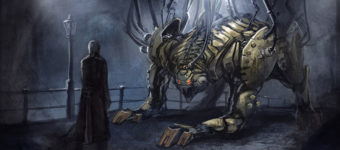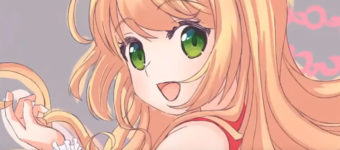
Writer & Storyboard Artist Lane Raichert Talks About His Career in the Entertainment Industry
Lane is an exceptionally talented man who has a lot of experience on some classic TV shows. My favorites include The Pirates of Dark Water, 2 Stupid Dogs, and definitely A Pup Named Scooby-Doo. He has also worked on web series and video game projects expanding into concept art, motion design, voice over production, and many areas of creative work.
Check out the full list of projects on his website and see if there’s anything you remember!
I am excited to share this interview with Lane discussing many different topics of his creative lifestyle. Currently he works as a freelancer-for-hire on all kinds of different projects. If you want to work with him feel free to get in touch and share your ideas.
I really agree with his attitude towards work and creative expression, especially working on bigger projects in the entertainment industry.
I hope you enjoy the interview and maybe learn a little something too.
What’s the history of how you got started in the entertainment industry?
My grandfather and father were both full-time professional artists, that was my biggest start.
As a kid I was swept away by several Willis O’Brien and Ray Harryhausen movies that I made my first stop-motion short when I was 8. I was also really into military models and history books, so I also made my first wargame at 8. As a teen I overdosed on J.R.R. Tolkien, Frank Herbert, Star Trek (TOS), and Star Wars, each filling my head & heart with dreams of being either a master model builder for George Lucas, or a famous epic novelist.
By the time I was 17 I was a full-on geek in love with several genres. Mostly SF and wargaming especially if it came from Japan. I even had a few freelance jobs under my belt by then; Things like drawing color dragons, or being paid to build my teacher’s giant Yamato battleship kit.
At 17 I had the king of lucky breaks when I was offered a private tour at Hanna-Barbera, courtesy of family friend Doug Booth. In 1980 Tex Avery and Chuck Couch had a production unit in Hanna-Barbera Studios making cartoons in the old 40s style(storyboards first, no scripts). With Margaret Loesch’s blessing, they kindly offered me an apprentice position there as a trial run.
I wasn’t very good at anything at the time, trust me. But I worked hard to learn as much as I could.
After a couple years doing mostly storyboards and pitch art Mark Evanier agreed to give me a chance at writing my first proper production script. I really enjoyed the writing process, and eventually grew into story editing and producing many years later.
I didn’t know it at the time, but my childhood years loving Lucy, Jeannie, Gilligan, and endless cartoon reruns would pay big dividends to me as a professional cranking out episodes under one crazy TV production schedule after another.
For 10 years I was on staff at Hanna-Barbera. First as a “Gag Man”(official title) until they changed the name to the more politically correct “Story Person.” Since 1990 I have been working as a full-time creative and production freelancer for companies big and small all over the world via our family service business, Raichert Media, Inc., which I co-run with my wife Valerie Raichert.
Do you have any special guidelines or structures to follow when writing dialogue for characters? How can you tell if a character is “believable” or not?
When orchestrating a cast, I like to make up a character grid to help my right-brain feel the differences. It’s just simple columns and rows of personality qualities listing how they are different from each other. But it’s a powerful writing tool. If two characters are too close in personality I change them until each cast member exists in their own distinctive space. Once that grid is built, writing dialogue for them becomes much easier.
Cast orchestration is kind of an experience similar to cooking or mixing music. In cooking, if you mix in 2 sweet ingredients, then all you have is sweet. But if you mix in both sweet and sour, then you get a more dynamic experience in your mouth. This is also true with dialogue and character chemistry – except the final emotional effect happens in your mind rather than in your mouth.
One good sign that we have successfully orchestrated believable characters is when a line of dialogue from one character sounds terrible if spoken by another character. Also if we take a random line of dialogue out of context, and no one can tell who said the line, then it’s usually time to go back to the grid to give the personalities more distinct and memorable qualities.
As far as dialogue believability, reading your text aloud is a good start.
Try stepping away from the work long enough to forget what it is. Then come back with an editor’s eye. Be honest with yourself and keep your ego out of it as much as possible. Pretend someone else wrote it.
Real dialogue from real people is direct and energetic, not convoluted and showy. Ask yourself “if a real person was saying this to me right now, would I believe it or would I roll my eyes at the seemingly prepared speech?”.
When brainstorming new concepts for a TV show, what do you think are the first ideas that should be planned out?
Character, character, then character. I read somewhere this idea that in movies the characters become our heroes, but in TV the characters become our friends. I love that, and it’s so true.
When we are invested in the characters and actually care about what’s going to happen to them, know what they love, what bugs them, then everything else follows naturally: plot, setting, theme, you name it.
I would love to hear more about your work as producer on A Pup Named Scooby-Doo. Could you walk through typical responsibilities, maybe a day-in-the-life working on that show?
Tom Ruegger produced the first season of A Pup Named Scooby-Doo; I produced the second and third. He set the tone of the series then I stepped into his large shoes and, hopefully, built on what he had so well put into motion.
Under Hanna-Barbera’s system at the time the producer was a sort-of production traffic cop and creative funnel in ways that lots of other studios give to their directors. Under that old H-B system, story editors were responsible for delivering up to the final approved script, and then the producers were responsible for hitting all the deliverables after that – up to and including the final air date.
A TV series production is a huge machine with millions of moving parts. At H-B in those days I did my best to hit what I perceived to be the producer’s two most important jobs: make sure all those parts keep moving, and lead the chain of command.
Imagine all these episodes at various stages, each moving down the schedule on their own track.
My life as a producer back then was a fire hose of creative and logistic choices – Yes, this storyboard is final. No, this model sheet needs revisions. Aren’t we late on that deliverable? How can we make up for lost time? No, this design won’t work for marketing. Yes, that shot looks bad but we don’t have time to improve it. Let’s assign the board artist this script on Wednesday. Here are the 22 retakes we are requesting for this episode – and so on, week after week after week.
For me the main reason why A Pup Named Scooby-Doo turned out better than usual, was because we had so many of the best people on hand: Tom Ruegger, Scott Jeralds, Glen Kennedy, Bill Matheny, Jennie Trias(our executive at ABC), John Debney, Jim Hickey, Victoria McCollum… then throw in a dream cast of Don Messick, Casey Kasem, Kellie Martin, Carl Steven, Christina Lange, and Scott Menville, ably directed by the likes of Andrea Romano and Kris Zimmerman(Salter). Wow.
When you get that many talented hard-working people on a single project, in key positions, doing everything right, you hit a certain escape velocity and the show starts to click. It is incredibly hard to pull off.
But when you are on a production that does manage to achieve this it’s very satisfying.
Between producing, directing, storyboarding, writing, and the other various creative jobs, what is your favorite and why?
That’s a hard one. But if you forced me, I’d have to go with writing. Why? I don’t know for sure.
I think it’s because story is seminal. It’s fun to be at the root being both inclusive and expansive.
I mean, if we go way back in time there are only so many movies you could make out of final art like the Venus de Milo statue. But we’ve been making paintings, statues, books, plays, and movies out of Homer’s writing(the Iliad) for 2,800 years now.
Will you share thoughts about the non-linear writing on Crimson Skies? I’ve never written in this style before so I’d be interested to know details about how it works and your thoughts on the process.
I find that the the anchor in linear writing is chronology, whereas the anchor in non-linear writing is context.
A few linear stories like Pulp Fiction, Memento, and Inception are good at breaking those boundaries. Still, with linear writing the audience rides on a fixed pre-set rail that you lay down. In a non-linear narrative like some video games, the rail is partially controlled by the audience. So as a writer it is freeing in a way because you are less constrained by chronology.
But it’s also more of a burden because if the characters aren’t interesting, it will become apparent quickly without the usual plot points and dramatic timings to prop them up.
So for my non-linear jobs like Crimson Skies or Cel Damage, I find the writing to be more of a canonical exercise: basically listing fun things these people would say and do under different situations. This is where the orchestration of interesting character traits on a grid can really make the job run smoother.
Do you have a particular favorite project that you’ve worked on?
No, that’s like picking your favorite child! There’s just too many that mean so much to me. I could never pick one.
If I can pick more than one, definitely. In TV I’m especially fond of ReBoot!, A Pup Named Scooby-Doo, Rolie Polie Olie, Addams Family, and my long storyboard career on so many shows including a couple boards I recently did on the Dragons: Riders of Berk series.
Which job(s) or project(s) have helped you grow and learn the most valuable lessons?
It’s less the jobs, and more the situations.
I find that either making big mistakes or working one notch above of my current skill level are the richest teachers. Those moments are usually nerve-wracking and unpleasant at the time. But when I look back on them, I can see how they made me better on so many levels.
How do you see digital video media evolving since you first started working in the field? Do you have any expectations of how things might change 5-10 years in the future?
The biggest pattern that leaps out to me is the decentralization of distribution and its subsequent explosion of viewer choice. When I started, there were essentially only five broadcast venues and one home video venue. Now there are thousands of established routes for “filmed” media to find its audience with millions upon millions of media offerings at the click of a button.
In the history of mankind artists have never had so much direct access to their audiences. We live in the most advanced and opportune time to submit creative efforts for public consideration – it’s a crazy abundance.
My guess for the future is that we will continue this trend away from centralized gatekeepers and keyed proprietary systems, towards the more open choice models. We end users will play or watch the media of our choice, on the device of our choice, when we choose.
I also think fabbing(fabrication, 3D printing) will be huge someday. The benefits of custom printing your own books or toys or comics or machines or trinkets on demand, I’m guessing, will out-compete the old “make 30 tons of the same thing and try to sell it to everybody” business model.
If you could share any final advice for aspiring creatives what would it be?
Two bits:
1. Trust your love of the medium. After work itself, this love of beauty is the engine for your career.
Almost all the creative professionals I’ve worked with, and certainly all the best ones, were once just like me: an amateur kid from nowhere special in the world who loved (fill in the blank). Maybe it’s the beauty they find in writing, or comic art, or Japanese animation, or in fight choreography, or skit comedy, or color, or composition, it doesn’t matter.
If you love it, if you work on it, you’ll get better at it.
Love > Taste > Opportunity > Work > Experience > Creative Career > Love.
2. Get it out of your head that companies are going to hire you because of your one killer idea. They are more likely to hire you because of your character, your professionalism, your energy, your vibe, or your potential.
The kind of work that you can output on demand is much more valuable than that awesome idea you’ve been nurturing all these years.
Ideas have their place, especially in equity projects or start-ups. But in established companies ideas are cheap, whereas professional hard-working talent is a treasure.
I want to thank Lane again for his time and very well-thought out answers. If you haven’t already seen his website then definitely take a peek at Raichert Media to see what else he’s up to.












